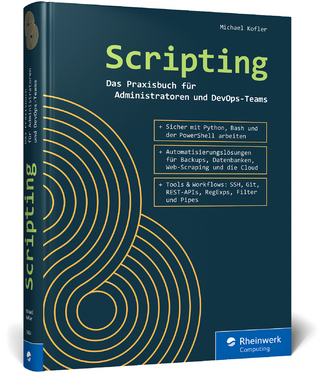
Mashup Patterns
Addison-Wesley Educational Publishers Inc (Verlag)
978-0-321-57947-8 (ISBN)
- Titel ist leider vergriffen;
keine Neuauflage - Artikel merken
Using new mashup tools and technologies, enterprise developers can impose their own APIs on everything from Web sites and RSS feeds to Excel and PDF files–transforming a world of content into their own customized informationsource. In Mashup Patterns, Michael Ogrinz applies the concept of software development patterns to mashups, systematically revealing the right ways to build enterprise mashups and providing useful insights to help organizations avoid the mistakes that cause mashups to fail.
Drawing on extensive experience building business-critical mashups, Ogrinz offers patterns and realistic guidance for every stage of the mashup development lifecycle and addresses the key issues developers, architects, and managers will face. Each pattern is documented with a practical description, specific use cases, and crucial insights into the stability of mashups built with it. Ogrinz concludes by presenting twelve start-to-finish case studies demonstrating mashup patterns at work in actual enterprise settings.
Coverage includes:
Understanding the relationships among mashups, portals, SOA, EAI/EII, and SaaS
Exploring core mashup activities such as data management, surveillance, clipping, transformation, enrichment, publication, and promotion
Optimizing security, privacy, accessibility, usability, and performance
Managing mashup development, from planning and governance through integration, testing, and deployment
Enhancing basic mashups with search, language translation, workflow support, and other improvements
Performing effective load and regression testing
Avoiding “anti-patterns” that cause enterprise mashups to fail
Also of interest: The companion book, Mashups: Strategies for the Modern Enterprise by J. Jeffrey Hanson (Addison-Wesley), is an indispensable guide to designing, implementing, and debugging an enterprise mashup, offering sample code to illustrate key concepts.
Michael Ogrinz is a principal architect at one of the world’s largest financial institutions. His business focus is to identify and integrate emerging technologies into the enterprise and to create innovative and competitive solutions. A frequent industry speaker on various facets of Enterprise 2.0, Michael has been instrumental in enhancing the computing environment at his firm through his work on user interfaces and usability, wikis and blogs, and, most recently, mashups. Michael cofounded localendar.com, a classic “garage start-up” that demonstrates how the “Long Tail” applies to online calendars as much as anything else. The niche site has provided more than 400,000 schools, churches, and clubs with simple online scheduling services since its inception more than eight years ago. Michael lives with his wife, two daughters, a collection of classic pinball and vector arcade machines, and a partially completed B9 Robot in wonderfully rural Easton, Connecticut.
Preface xiii
Acknowledgments xix
About the Author xxiii
About the Cover Picture xxv
Chapter 1: Understanding Mashup Patterns 1
Introduction 1
Web 2.0 2
Enterprise 2.0 4
The Birth of Mashups 7
Types of Mashups 9
Acquiring Data from the Web 12
The Long Tail 18
Meeting User Demand 19
Mashups and the Corporate Portal 20
Mashups and Service-Oriented Architecture 22
Mashups and EAI/EII 24
Mashups and Software as a Service 25
Mashups and the User 27
A Patterns Primer 28
The Fragility Factor 29
The Future of Mashups 31
Chapter 2: Mashup Patterns Terminology 33
Introduction 33
Semantics 33
Structure 36
Where’s the UML? 38
Summary 39
Chapter 3: Core Activities 41
Introduction 41
Support for Open Standards 42
Data Extraction 44
Data Entry 48
Data Visualization 51
Scheduling and Surveillance 53
Clipping 54
Transformation and Enrichment 56
Action 59
Publication and Promotion 62
Assembly Canvas 63
Summary 65
Chapter 4: Harvest Patterns 67
Introduction 67
Alerter 70
API Enabler 76
Competitive Analysis 83
Infinite Monkeys 90
Leading Indicator 96
Reality Mining 102
Reputation Management 109
Time Series 115
Chapter 5: Enhance Patterns 121
Introduction 121
Accessibility 123
Feed Factory 129
Field Medic 135
Folksonomy Enabler 141
Fragility Reducer 146
Smart Suggestions 151
Super Search 158
Translation 165
Usability Enhancer 171
Workflow 180
Chapter 6: Assemble Patterns 189
Introduction 189
Communication and Collaboration 191
Content Aggregation 199
Content Integration 207
Distributed Drill-Down 213
Emergency Response 218
Filter 226
Location Mapping 233
Splinter 239
Chapter 7: Manage Patterns 245
Introduction 245
Content Migration 248
Dashboard 255
Portal Enabler 262
Quick Proof-of-Concept 269
Single Sign-on 274
Widget Enabler 281
Chapter 8: Testing Patterns 289
Introduction 289
Audit 292
Load Testing 299
Regression Testing 305
Chapter 9: Anti-patterns 311
Introduction 311
Skinny Window 313
Drinking Seawater 315
Sticky Fingers 317
Shadow Integration 321
Dirty Laundry 324
Open Kimono 327
One-Hit Wonder 329
Malicious Hitchhiker 332
Chapter 10: Final Thoughts 337
Introduction 337
Mashing Up Binary Types 338
Security 340
Conclusion 344
Appendix: Corporate Case Studies 347
Introduction 347
Afni 349
Associated Press 353
Audi 356
Defense Intelligence Agency 358
MICROS Systems 361
Philadelphia Stock Exchange 364
Simply Hired 367
Thomson Financial 370
Thomson Reuters 374
A European Credit Union 377
A Financial Publisher 379
A Government Aerospace Contractor 382
An Investment Bank 385
A Telecommunications Provider 389
Index 393
| Erscheint lt. Verlag | 26.3.2009 |
|---|---|
| Verlagsort | New Jersey |
| Sprache | englisch |
| Maße | 180 x 235 mm |
| Gewicht | 699 g |
| Themenwelt | Mathematik / Informatik ► Informatik ► Netzwerke |
| Mathematik / Informatik ► Informatik ► Web / Internet | |
| ISBN-10 | 0-321-57947-X / 032157947X |
| ISBN-13 | 978-0-321-57947-8 / 9780321579478 |
| Zustand | Neuware |
| Haben Sie eine Frage zum Produkt? |
aus dem Bereich


